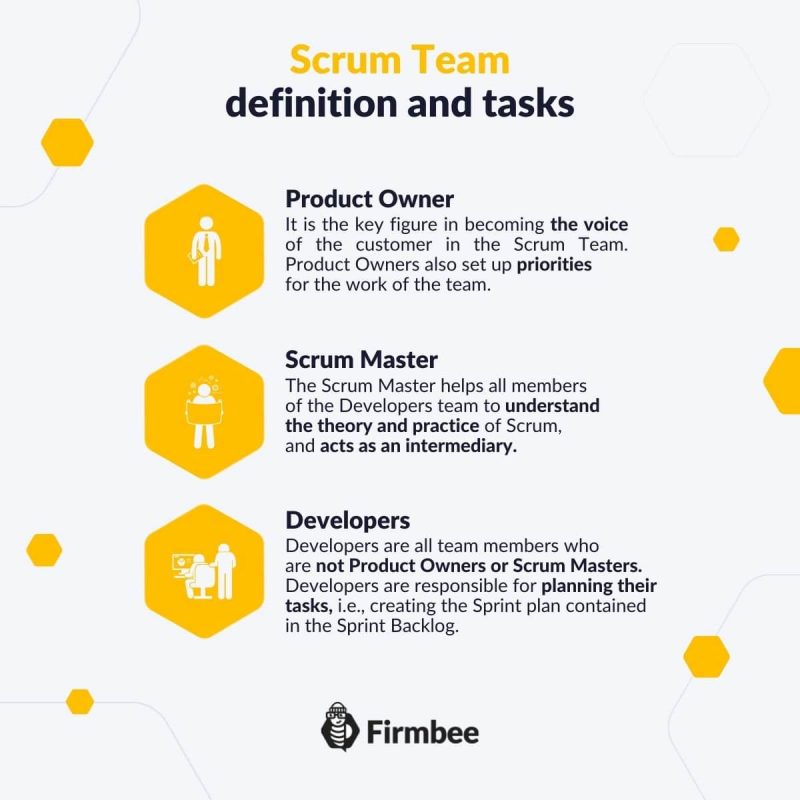Scrum Team is a team working according to Scrum principles. Its most important feature is the lack of internal hierarchy. Once the goal and scope of tasks to be done in a Sprint are agreed upon, team members take the initiative. From that moment on they make their own decisions about who, how, and when will do what. How does such a self-managing team work?
Scrum Team – table of contents:
Scrum Team – definition and tasks
The Scrum Team as a whole is accountable for its actions. Therefore, it must have the authority to manage its work. This is especially significant in larger organizations. If the team is to operate following Scrum principles, the rhythm and manner of its activities cannot be disturbed from the outside. But of course, within a Scrum team, each person has their specific responsibilities.
The main task of the whole team is to work towards achieving Product Goal. The realization of this Goal is spread into short Sprints. In each Sprint, the Scrum Team builds a new working part of the project, the Increment. Small tasks performed by the team are well defined within a Sprint and distributed among the team members.
Composition
Typically, Scrum Team consists of no more than ten people. It should include open-minded professionals whose competencies complement each other. The composition of Development Team changes depending on the ongoing project. However, there are always two key figures: Product Owner and Scrum Master. We will devote them separate entries in the following articles, so here we will only briefly outline their significance for the team.

Product Owner
The Product Owner is a team member equal in the hierarchy. But above all, he is the voice of the customer in the Scrum Team. The Product Owner’s primary responsibility is to communicate with the customer and then set priorities for the team’s work. This is reflected in both the Product Objective and the content of the Product Backlog. It is the Product Owner who answers questions about the Product asked by other team members by taking the customer’s perspective. He therefore ensures that the direction and purpose of the development team is clear. He also accepts the work done by the developers and approves the delivery of the result to the customer.
Scrum Master
The Scrum Master helps all members of the Developers team to understand the theory and practice of Scrum, and acts as an intermediary. Often they are at the same time members of the Development Team and the Product Owner’s support. Still, only Scrum Master is responsible for the functioning of the team and its operations according to Scrum principles.
They must watch over the team, to become both a leader and a coach. Scrum Masters focus on observing shortcomings and implementing upgrades and fixes. Additionally, Scrum Masters monitor the efficiency and effectiveness of Developers’ work.
Developers
Developers are all team members who are not Product Owners or Scrum Masters. The name shouldn’t confuse you – it’s not just about programmers. Developers can be people with very different skills and responsibilities.
Developers are responsible for planning their tasks, i.e., creating the Sprint plan contained in the Sprint Backlog. And also the daily work of developing the Product in order to produce in each Sprint a useful Increment (increase) according to the Definition of Completion.
Scrum Team Operation
A Scrum Team is interdisciplinary in nature. This does not mean, of course, that everyone can perform every task set before the Scrum Team. Its members together have all the skills necessary to perform the task and manage their own work.
That’s why it’s important to build trust between the people in the Scrum Team. And also building trust by the organization to the Scrum Team as a whole and giving it independence. This is what will motivate its members to undertake more difficult tasks, beyond their daily responsibilities.
Interdisciplinarity not only helps in making the team more productive. It also makes the professionals from different disciplines working as a Scrum Team able to help each other in completing the tasks set for the team, complementing their skills.
This requires the skill of working together. Moreover, each team member has to possess general knowledge of what each person does. This way, Scrum Team participants know who to turn to for expert help if they have a problem with a task.

Summary
In summary, Scrum Team is a team consisting of Product Owner, Scrum Master and Developers. Its main task is to achieve the Product Goal by producing valuable Increments in each Sprint. A Scrum Team is an interdisciplinary group of professionals managed from within. The competencies of the team members complement and strengthen each other through mutual help, frequent feedback and commitment.
If you like our content, join our busy bees community on Facebook, Linkedin and Twitter.
Author: Caroline Becker
As a Project Manager, Caroline is an expert in finding new methods to design the best workflows and optimize processes. Her organizational skills and ability to work under time pressure make her the best person to turn complicated projects into reality.
Scrum Guide:
- Glossary of basic terms, roles and notions
- What is Scrum?
- Scrum values
- How to implement Scrum in your company?
- Scrum Team - what is it and how does it work?
- Who is a Product Owner?
- The most common mistakes of Product Owner
- Who is the Scrum Master?
- Characteristics of a good Scrum Master
- The most common mistakes of Scrum Master
- What statistics and metrics should the Scrum Master track?
- Cooperation between Product Owner and Scrum Master
- Development Team in Scrum
- The most common mistakes of Developers
- Scrum artifacts
- Scaling Scrum
- Sprint Backlog
- What is the Product Backlog?
- What are User Stories?
- Creating the best User Story with INVEST
- The most common User Story mistakes
- User Story Acceptance Criteria
- Estimation and Story Points in Scrum
- Planning Poker
- Team Estimation Game
- Defining Increment
- Scrum events
- What is Sprint in Scrum?
- Scrum Team Commitments - Product Goal, Sprint Goal and Definition of Completion
- What is a Burndown Chart?
- How to create and interpret a burndown chart?
- Advantages and disadvantages of the burndown chart
- Kanban boards in Scrum and Scrumban
- Velocity in Scrum - Speed of the Development Team
- Daily Scrum
- Sprint Planning
- Sprint Review
- What is a Sprint Retrospective?
- Common mistakes during a Sprint Retrospective
- Product Backlog nurturing


















